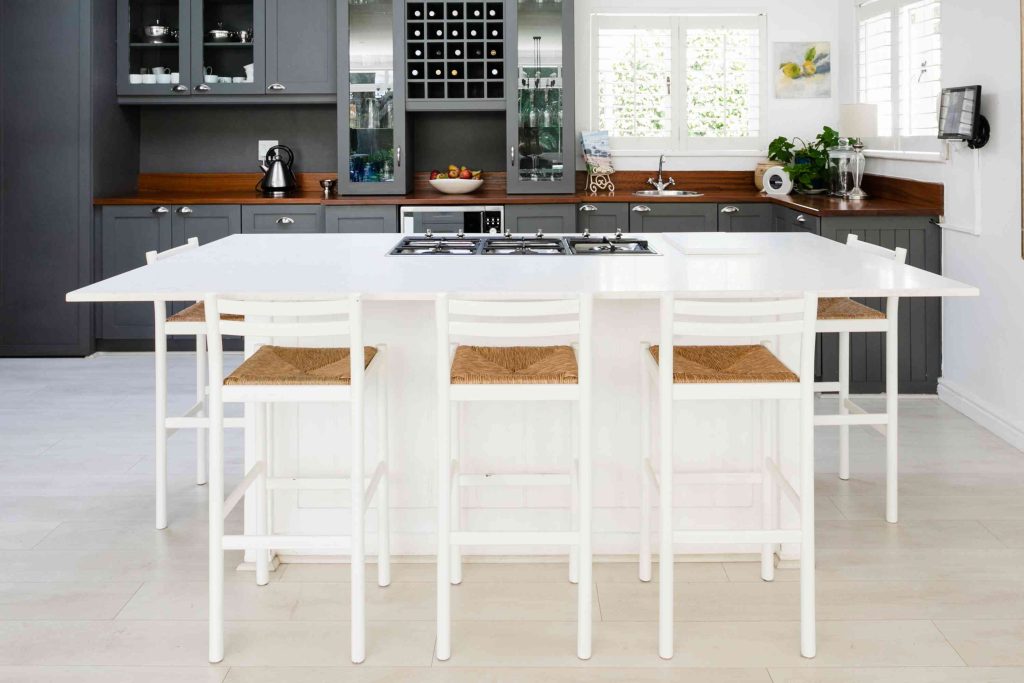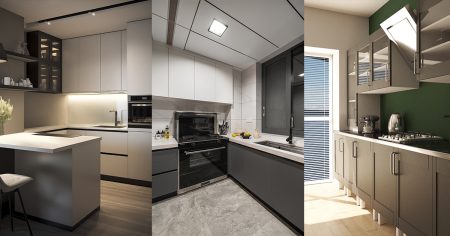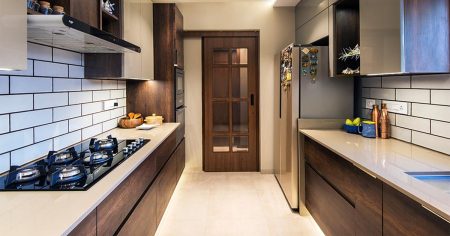Kitchen islands provide kitchens with more cooking, washing, and prep areas, as well as more storage and cabinet space for cookware. But whenever you add an object as large as an island, space issues need to be considered.
An oversized kitchen island can eat too much space, impede kitchen traffic, and visually overwhelm the room. Cooktops misplaced on the island make cooking for difficult, and poorly located outlets may not meet code. Learn how to create, place, and space your kitchen island and its peripheral services.
Kitchen Island Size and Spacing
A kitchen island should take up no more than 10-percent of the total square footage of the kitchen. If the kitchen island is larger, it may dominate the kitchen, make it difficult to maneuver, and become a visual distraction.
For example, if a kitchen’s total size is 10 feet by 13 feet (130 square feet) and its kitchen island is 4 feet by 7 feet (28 square feet), then the island is too large. Over 20-percent of the kitchen floor space is given over to the island with this example.
The solution is easy: Narrow the kitchen island from 4 feet wide to 2 feet wide. Four-foot-wide islands are less common than those that are 2 feet wide. An island properly sized for this space would be around 13 to 14 square feet.
At a minimum, a kitchen island should be at least the size of two kitchen base cabinets, or about 4 feet long by about 2 feet deep (27 inches). Most kitchen islands are built from stock or semi-custom kitchen cabinet bases.
Experiment with your intended kitchen island size by placing a small table in the space for a few days. Expand the table visually by taping cardboard to the table surface to mimic the size of the intended island. Elevate the table by placing books under each of the four legs to raise the table surface to 36 inches for standard kitchen islands and 42 inches for eating/sitting kitchen islands. Large cardboard boxes can also simulate the mass of a kitchen island.
Kitchen Island Stove and Cooktop Planning
A stove or a cooktop in or on the kitchen island gives you increased working room, extra burners, and an alternative cooking area if the primary cooking area is busy. Not only that but centralized stoves create a more social atmosphere, especially when bar chairs are added to one side of the island.
However, consider whether you are ready to break your cooking area away from the perimeter. This across-aisle back and forth can frustrate some cooks who are accustomed to having a tight, unified sink-counter-stove classic kitchen triangle work area.
For such cooks, a kitchen island cooktop can be a secondary, overflow mode of cooking; the primary stove would still be located in the perimeter countertop area.
For island cooktops or stoves, electrical or gas lines must be brought up from the floor, through the crawlspace. If your home is built on a concrete slab, the concrete must be broken up and pipes laid under the slab.
Kitchen Island Hood and Exhaust Planning
Burning food and blaring smoke detectors seriously detract the cooking—and eating—experience. In primary cooking areas along the perimeter, the solution is to add an exhaust fan and hood. A vent carries smoke and cooking odors to the exterior, out the side of the wall or up through the roof.
Kitchen islands are not adjacent to walls, so they lack easy access to venting as well as electrical power. Kitchen islands can be vented either upward or downward.
Kitchen Island Upward Venting
Cooktop and stove installations in kitchen islands often drape a hood over the stove. The hood is attached to the ceiling. The vent may continue directly up and out the roof or it may go up and turn to the side. Electrical power lines usually run through attics, as well.
Because smoke and steam rise, venting upward tends to be the best option from a functional standpoint. The downside is that you will have a hood and vent looming in the middle of the room.
Kitchen Island Downward Venting
When island upward venting is not possible or not desired, smoke and odors can be vented downward.
With some cooktops, a grate in the stove next to the burners pulls the smoke straight down and then out of the house through a vent that runs through the crawlspace.
Aesthetically, downward cooktop venting is best since there is no hood hanging over the cooking area. But downward venting is rarely as effective as upward venting. For cooks that expect to use the island cooktop only rarely, downward venting may be best.
Kitchen Island Receptacles
Receptacles are not required on kitchen islands. When receptacles are placed on kitchen islands, the National Electrical Code (NEC) requires each outlet servicing the countertop to be GFCI-protected.
The initial 9 square feet of countertop space must have one outlet, and every additional 18 square feet must have one outlet. So, a 45-square-foot countertop must have three outlets at a minimum.
Kitchen Island Storage Space
Kitchen islands are great storage areas. The kitchen base cabinets chosen for the island can be open inside, shelved, or a combination.
Make the best of this island storage space by adding drawers, pullouts, sliders, lazy-susans, and shelved cabinet space.
Generally, the more cavernous the space, the less valuable it is for storage. If you lack woodworking skills, this may be the time to hire a qualified carpenter to build out shelves, sliders, and drawers. Or simply purchase semi-custom cabinets that fit your specifications.
Pairing Kitchen Islands With Freestanding Kitchen Islands
If your kitchen island isn’t as large as you would like, think outside of the box—literally.
One quick solution is to pair that space-starved permanent kitchen island with a freestanding rolling or table-style kitchen island. This gives you the extra counter space that you want, but with an escape plan. If you should decide that you don’t like the arrangement, locate the mobile island elsewhere in the kitchen or even in another part of the house.
Each surface should provide a different value. For example, a freestanding island with a large butcher block might be used only for chopping meat and veggies.
Pair this with a permanent island for mixing, using small appliances, and other prep work. The permanent island will typically give you two additional electrical outlets, a requirement based on the electrical code.
Read the full article here














